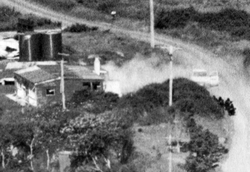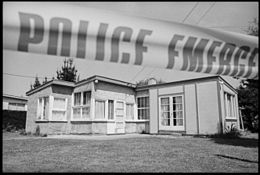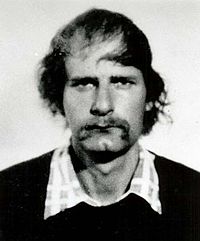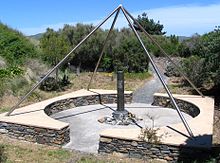- Aramoana massacre
-
Aramoana massacre 
Special Tactics Group officers crouch on Muri Street (right), before storming Gray's beach house (left)Location Aramoana, New Zealand Date 13–14 November 1990
7:30 p.m. – 5:50 p.m.Attack type Spree Killing Weapon(s) .223 Norinco Type 84s (AK-47 clone)[1][2] Death(s) 14 (including the perpetrator) Injured 3 Perpetrator David Malcolm Gray The Aramoana massacre was a mass murder that occurred on 13 November 1990 in the small seaside township of Aramoana, New Zealand.[3] Resident David Gray, a 33-year-old unemployed man, began indiscriminately shooting people in the township with a scoped semi-automatic rifle, after a verbal dispute with his next-door neighbour. He shot neighbours and a family visiting the township,[4] killing thirteen people, including local police Sergeant Stewart Guthrie, first responder to the reports of a shooting. After a careful house-by-house search the next day, police officers led by the Special Tactics Group located Gray and shot him dead as he came out of a house firing from the hip[1][2] (media reporting at the time called the group by the pre-1990 name, the Anti Terrorist Squad). It is the deadliest criminal shooting in New Zealand history.[5]
Contents
Timeline of events
Spree
The massacre began on 13 November at 7.30 pm when Gray confronted neighbour Garry Holden about one of Holden's daughters wandering onto his property. After the confrontation, Gray went into his house, retrieved a Norinco 84S semi-automatic rifle, walked outside and shot Holden dead.
Nearby were three young girls: Holden's two daughters, Chiquita and Jasmine, and his girlfriend Julie's adopted daughter, Rewa. The girls ran into Holden's house as Gray walked onto Holden's property. He quickly found Chiquita and shot her through her left arm and chest with a Squires and Bingham .22 semiautomatic sporting rifle, the bullet lodging in her abdomen.[6]
The wounded girl fled past her father's body to the nearby house of Julie Ann Bryson, while Gray set the Holden house on fire. Bryson, realising that Rewa and Jasmine were still in the Holden house, drove her van there with Chiquita in an attempt to save the girls. Gray shot at the van as it passed the house, which was by now ablaze.
Gray started shooting indiscriminately, targeting a utility vehicle full of locals who had seen the Holden house burning and stopped to help. He first shot Vanessa Percy as she ran down the street in terror, then killed two young boys, Leo Wilson and Dion Percy. The boys' sister, Stacey, received severe wounds to her abdomen.[7] Ross Percy, the children's father, who had been driving them home after a day fishing when they saw the fire, was the next to die, followed by Aleki Tali, who had also been with them fishing that day. Gray then entered the home of Tim Jamieson, killing him and another elderly local, former Green Island mayor Vic Crimp. The next victim was James Dickson, who was looking for his dog, Patch. Helen Dickson, James' mother, and neighbour Chris Cole went into the road to see what the noise was. Gray shot at both of them, wounding Cole and forcing Helen to dive for cover. Helen, who had recently had a hip replacement and was unable to walk without assistance, pulled herself along on her stomach using her arms and feet in a ditch to get inside and phone for help. She then crawled back to Cole to tell him help was coming.
After waiting for some time, Helen again crawled back to her house and phoned 111 emergency. By this stage it was getting dark and the dispatcher advised her to stay inside. Helen later received the George Medal for bravery.[8] Help arrived too late for Cole, who died in the hospital.
First responders
The first police officer to arrive was Sergeant Stewart Guthrie, officer in charge of Port Chalmers police station and an NCO in the Armed Offenders Squad (AOS).[9] He came armed with a .38 Smith & Wesson police revolver (at the time of the massacre New Zealand police ordinarily did not carry firearms) and enlisted the help of Constable Russell Anderson, who had arrived a short time earlier with the fire service. He armed Anderson with a rifle belonging to a resident. With darkness approaching, the pair moved through the township to Gray's house, where Guthrie deployed the constable to cover the front while he moved to cover the more dangerous rear of the house. A detective, Paul Knox, and two constables arrived, starting the first step of the "cordon, contain, appeal" standard police strategy for armed offenders.[10] Guthrie observed Gray and relayed his movements inside the house to police headquarters.
After some time he lost sight of the gunman, and advised the detective to warn everyone to be alert. Anderson spotted Gray coming out the front of his property and issued a challenge, at which the gunman retreated quickly, passing through the rear of his property. Taking cover in the sand dunes of a neighbouring crib, Guthrie encountered Gray coming out of the darkness. Yelling at the gunman to surrender, he fired a warning shot. Gray shouted, "Don't shoot!", leading Guthrie to believe he was surrendering. However, Gray suddenly fired several times, one shot striking Guthrie in the head, killing him instantly.[8]
Minutes later the Dunedin branch of the AOS began to arrive and sealed off the township with a roadblock about 250 metres along the only road out of Aramoana, securing it with an armoured car.[5] AOS units from Christchurch, Timaru and Invercargill were called in for support. The situation was considered dangerous as Gray had a scoped rifle, making him potentially accurate at long range.
Special Tactics Group
Armed police search cribs in Aramoana for David Gray, November 14.
Commissioner of Police John Jamieson authorised the Special Tactics Group (STG), the specialist counter terrorist unit, to travel to Dunedin and locate Gray,[11] group members were in Christchurch, Wellington and Auckland. Unable to get transport with the Air Force, the group caught the early morning business flight on the 14th.[12] They took Heckler & Koch MP5 submachine guns, encountering some problems taking firearms on a commercial aircraft. Also on the flight were Minister of Police John Banks, the Commissioner, and Julie Holden, who described Aramoana to the STG.[12] A large number of reporters met the flight on arrival at Dunedin. A bus took the STG to Port Chalmers, which was choked with vehicles, where residents from Aramoana briefed the group about the township and Gray.[13]
STG members took a reconnaissance flight over the township in an Air Force Iroquois. The helicopter initially flew high as it had no armour from small arms fire; Gray had shot at a private news helicopter earlier that morning.[14] The crew of the Air Force Iroquois then carried out low, slow passes over areas of bush where Gray was believed to be hiding, carrying armed police and dropping tear gas grenades as it did so, in an attempt to 'flush him out'. The Iroquois crew flew for over eight hours in support of the operation during the day, including positioning police snipers in the surrounding hills. After the initial reconnaissance flight the STG moved out as two squads and met up with the Timaru AOS, who were holding positions. The group received fire orders: "if he has a firearm, he is to be shot".[9] Meanwhile, Gray had entered a crib, eaten a small meal and gone to sleep.
Some Christchurch members of the STG moved into Aramoana at about 6:00 am on November 14.[15] The STG went first to Gray's house, passing bodies on the street. After clearing neighbouring houses they put a stun grenade into Gray's, blowing out the windows, followed by tear gas. Kicking down the door, they discovered it was empty.[16] The group then worked down the road, checking each house, a squad on either side of the street. The STG called up the AOS, with members from Wanganui, Palmerston North, Napier, and New Plymouth, to their backs. The group discovered Sergeant Guthrie's revolver in a garden, and a woman who had been hiding under a table for more than twenty hours.
 The house in Aramoana where David Gray was shot dead on November 14, 1990.
The house in Aramoana where David Gray was shot dead on November 14, 1990.
After a long day searching from house to house, the STG checked a crib with a broken window on the north-eastern side of the township. The crib had large hedges on both sides, and a fibrolite shed at the rear. The group spotted Gray briefly at a window, and a battle ensued. Police put a stun grenade through a window, but it bounced off a mattress that Gray had placed as a barricade and landed back near police. Police fired teargas into the crib. Gray began shooting not at police but through the fibrolite shed. The STG opened fire, both sides shooting for two minutes, Gray walking around inside firing randomly.[1] A stray bullet that passed through the crib struck an STG officer in the ankle.[1] As soon as the shooting erupted, the Air Force Iroquois took up position overhead to help ensure Gray could not escape into nearby bushes in the fading light of the approaching second night.
At around 5.50 pm, Gray ran out of the house, shooting from the hip and shouting "Kill me! Fucking kill me!"[1][2] He took several steps before being struck and knocked down by STG gunfire. Gray was hit five times: in the eye, neck, chest and twice in the groin. Even with these injuries, he struggled fiercely against police, breaking free of plastic handcuffs before being re-handcuffed, while berating police for not having killed him.[2] Ambulance officers treated him at the scene and on the way to Dunedin hospital by providing him oxygen, but the ambulance did not get very far out of Aramoana and at 6:10 Gray died.[17]
Inside the crib police found a .22 Winchester rifle fitted with a silencer, an air rifle, hundreds of rounds of .22 ammunition, and approximately 100 rounds of .223 ammunition. Gray was carrying a .22 Remington rifle as well as the .223 Norinco when he was shot.[2] Police had fired between 50 and 60 shots,[18] and at least 150 police officers were involved in the operation.[19]
Rewa Bryson and Jasmine Holden's charred bodies were found in what remained of the Holden family home. Fourteen people including Gray were dead.
Perpetrator
The perpetrator of the massacre was 33-year-old David Malcolm Gray (November 20, 1956 – November 14, 1990), an unemployed resident of Aramoana. Gray was born in Dunedin, New Zealand, and was raised in Port Chalmers.[20] His father, David Francis, worked in a manufacturing company and his mother, Mary Elizabeth, was a machinist. He had two siblings, sister Joan and brother Barry.[20][21]
Gray attended Port Chalmers Primary School, and later enrolled at the Otago Boys' High School from 1971 to 1973,[21][22] where he was a mid-stream student.[20] A former classmate stated Gray was quiet and unassuming, but that "there was nothing frightening about him then".[21] Those who knew Gray remembered him as having been a loner since primary school. He had worked occasionally as a farmhand but had been unemployed for a few years before 1990.[20][23]
He had lost both his parents — his father in 1978,[20][24] and his mother in 1985.[25] His sister said the death of their mother deeply affected David, and prompted him to move from Port Chalmers to the Gray family holiday home in Aramoana.[21][26]
Gray was a regular customer at Galaxy Books and Records in Dunedin. Bill Brosnan, the store owner, knew him for seven years and said he was a fan of military books and Soldier of Fortune magazine.[20][23] In January 1990, Gray threatened an assistant of the bookshop with what appeared to be a shotgun in a cardboard box, and Brosnan served him with a trespass notice in February.[23]
His sister said he was an animal lover; locals said this was a source of conflict with his next-door neighbour Garry Holden, whose pets kept dying.[21]
Casualties
Killed
- Rewa Ariki Bryson, 11, friend of Jasmine
- Simon Christopher "Chris" Cole, 62
- Victor James "Vic" Crimp, 71
- James Alexander "Jim" Dickson, 45
- Sergeant Stewart Graeme "Stu" Guthrie, 41, Port Chalmers police officer
- Garry John Holden, 38
- Jasmine Amber Holden, 11, daughter of Garry Holden
- Magnus "Tim" Jamieson, 69
- Ross James Percy, 42
- Vanessa Grace Percy, 26, wife of Ross Percy
- Dion Raymond Jack Percy, 6, son of Ross and Vanessa Percy
- Aleki Tali, 41
- Leo Wilson, 6
Wounded
- Stacey Percy, 4, daughter of Ross and Vanessa Percy
- Chiquita Holden, 9, daughter of Garry Holden
- Stephen Vaughan, Wellington police officer
Causes
Gray's mental and physical state worsened in the months leading up to the attack. There was some evidence of a progressive decline in his mental state before the shootings, as he alienated the few friends he had. On the morning of 13 November he travelled into Dunedin city, and visited a bank where he objected angrily to a NZ$2.00 bank fee for a cheque.[27] He then went to Elio's Gun Shop, placing a $100 deposit on a gun he intended to collect the next week. At the Continental Coffee Bar he was served a cold pie, and became confrontational. After being asked to leave, he threatened the owners saying: "I'll be back, I'm going to get you. I'll blow you away."[28]
Aftermath
Three days after the incident Gray's house at 27 Muri Street in Aramoana was deliberately set on fire and burnt to the ground.[29] The Port Chalmers Fire Brigade attended and doused surrounding vegetation to prevent the fire spreading; around fifty residents watched it burn. Gray's relatives asked that any investigation of arson be stopped, when contacted by police.[30]
The massacre is the most deadly criminal shooting rampage in New Zealand's history. It sparked lengthy debate about gun control, as Gray's primary weapon was a Semi-Automatic rifle, with a similar appearance to and internal mechanism based on the Russian AK-47. The incident directly resulted in an amendment to New Zealand's firearms regulations in 1992, tightening gun control and the creation of the Military-Style Semi-Automatic category of firearms. The Government of the day were led to believe that Gray had shot all his victims with an AK47 7.62 x39mm assault rifle. It was subsequently proven that Gray used several firearms, none of which were an AK47 assault rifle. Four of the Aramoana victims were proven to have been shot with a Norinco 84s .223 semiautomatic sporting rifle.
Many of the officers involved received gallantry awards, Sergeant Guthrie receiving a posthumous George Cross.[8] A memorial to the victims was erected in the township.
Cultural Influence
Books
At least two non-fiction books have been written about the shootings: Tragedy at Aramoana by journalist Paul Bensemann,[31] and Aramoana: Twenty-two hours of terror by police officer Bill O'Brien.[32] There are chapters devoted to the shootings in Gordon Johnston's history of the settlement, Journey to Aramoana - His Story,[33] and Confessions from the front line by STG leader Murray Forbes.[34]
Film and television
A movie based on the massacre, Out of the Blue, directed by Robert Sarkies, premiered at the Toronto International Film Festival on September 12, 2006.
The production faced some opposition from some citizens in Aramoana. However, eventually the community allowed some scenes to be shot in the township. They agreed to the making of the movie only if the title was not "Aramoana" and if they were to see the movie beforehand.
Music
The Mutton Birds refer obliquely to the massacre{{fact]} in the song "A Thing Well Made" on their self-titled debut album. The song is narrated by a man who owns a sporting goods store in Christchurch. As the song closes he describes his work for the day, which involves sending "one of those AK-47s for some collector down the line." Dunedin band The Chills more directly address the Aramoana incident in the song "Strange Case" from the 1992 album Soft Bomb. Within three weeks of the shootings, Wellington band Goatrider had written and performed a song about them called "David Gray", which appeared on their FTS cassette release in 1992.
See also
- List of massacres in New Zealand
References
Citations
- ^ a b c d e (Forbes 1997, p. 206)
- ^ a b c d e Spencer, Leigh (16 November 1990). "Gunman called 'Kill me' as he rushed police". Otago Daily Times. pp. 1.
- ^ Staff Reporters (14 November 1990). "GUNMAN ON RAMPAGE". Otago Daily Times. pp. 1.
- ^ Benson, Nigel (15 November 1990). "Day's outing for Port family turns to tragedy". Otago Daily Times. pp. 2.
- ^ a b Staff Reporters (15 November 1990). "HOURS OF TERROR END". Otago Daily Times. pp. 1.
- ^ Jones, Lea (5 November 2005). "Return to Aramoana". New Zealand Herald. http://www.nzherald.co.nz/nz/news/article.cfm?c_id=1&objectid=10353715. Retrieved 2008-10-18.
- ^ "'Don't shoot me' wounded four-year-olds plea". Otago Daily Times. 16 November 1990. pp. 2.
- ^ a b c London Gazette: (Supplement) no. 52837. pp. 2783–2784. 17 February 1992. Retrieved 2008-01-10.
- ^ a b (Forbes 1997, p. 203)
- ^ "Armed Offenders Squads". New Zealand Police. http://www.police.govt.nz/service/aos/. Retrieved 2008-10-18.
- ^ (Forbes 1997, p. 199)
- ^ a b (Forbes 1997, p. 200)
- ^ (Forbes 1997, p. 201)
- ^ (Forbes 1997, p. 202)
- ^ http://tvnz.co.nz/national-news/tvnz-wins-high-court-appeal-over-aramoana-story-4486488/video
- ^ (Forbes 1997, p. 204)
- ^ Police Complaints Authority. Report of Police Complaints Authority on tragedy at Aramoana, 19 December 1990.
- ^ (Forbes 1997, p. 207)
- ^ "Sobering sights as Banks, Jamieson visit". Otago Daily Times. 15 November 1990. pp. 2.
- ^ a b c d e f Gibb, John (18 November 1990). "Gray made few contacts". Otago Daily Times. pp. 1.
- ^ a b c d e Gibb, John and the NZPA (17 November 1990). "Sister shocked Gray could be crazed killer". Otago Daily Times. pp. 1.
- ^ "Class List". Otago Boys’ High School Foundation. http://www.obhsfoundation.co.nz/my_profile/my_class_list.cfm?searchpage=51&YEARSTARTED=1971. Retrieved 2008-10-18.
- ^ a b c Someville, Philip (15 November 1990). "Police 'warned' of Gray's mental state". Otago Daily Times. pp. 1.
- ^ "Cemetery Details". Dunedin City Council. http://www.dunedin.govt.nz/facilities/cemeteries/cemeteries_search?recordid=144273&type=Cremation. Retrieved 2010-02-07.
- ^ "Cemetery Details". Dunedin City Council. http://www.dunedin.govt.nz/facilities/cemeteries/cemeteries_search?recordid=149474&type=Cremation. Retrieved 2010-02-07.
- ^ Gibb, John (17 November 1990). "Profile of a mass murderer". Otago Daily Times. pp. 19.
- ^ (O'Brien 1991, p. 60)
- ^ (O'Brien 1991, p. 62)
- ^ Matthews, Philip (October 2006). "The spirit of Aramoana". The Listener. http://www.listener.co.nz/issue/3465/features/7189/the_spirit_of_aramoana,1.html. Retrieved 2008-10-29.
- ^ Spencer, Leigh (19 November 1990). "Gray house razed, inquiry called off". Otago Daily Times.
- ^ (Bensemann 1991)
- ^ (O'Brien 1991)
- ^ (Johnston 1992, p. 137–145)
- ^ (Forbes 1997, p. 199–208)
Sources
- O'Brien, Bill (1991). Aramoana : Twenty-two hours of terror. Auckland: Penguin. ISBN 0-14-016819-2
- Forbes, Murray J. (1997). Confessions from the front line. Sandringham, Auckland: Howling at the Moon Productions. ISBN 0958356858
- Johnston, J. Gordon (1993). Journey to Aramoana : His story. Dunedin: Johnston. ISBN 0-473-01683-4
- Bensemann, Paul (1991). Tragedy at Aramoana. Lower Hutt: Imprint. ISBN 0-908561-32-6
External links
- Firing at Sundown article in TIME magazine, 26 November 1990
- The Aramoana Massacre article at crime.co.nz — contains some inaccuracies with timeline.
Coordinates: 45°46′39″S 170°42′12″E / 45.7775°S 170.70333°E
Categories:- Mass murder in 1990
- 1990 in New Zealand
- Murder in New Zealand
- Deaths by firearm in New Zealand
- Gun politics in New Zealand
- Massacres in New Zealand
- People murdered in New Zealand
- Spree shootings in New Zealand
- History of Dunedin
- History of the Otago Region
Wikimedia Foundation. 2010.



